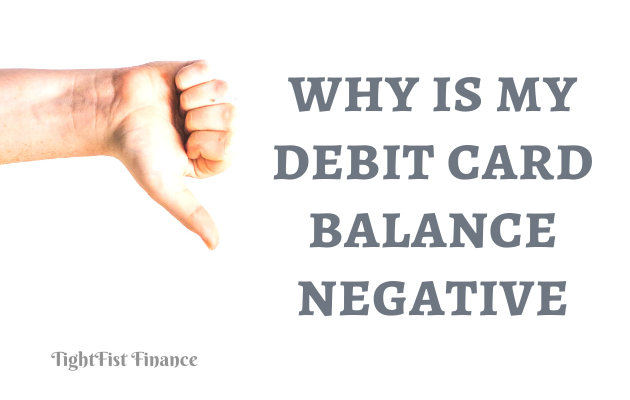Why is my debit card balance negative?
When your direct card balance is negative, you caused an overdraft which means you’ve spent more money than you have. Your bank has opted to honor an outgoing payment, even though you didn’t have enough cash in your account. This can happen if you set up a subscription or perhaps pay certain bills automatically.
We’ve all been there. We tried to make a purchase, and it wouldn’t go through. You then check the balance on your debit card, and it is negative. How did this happen?
Luckily for you, I’ll show you why your account balance can go below zero. I’ll show you if there are any charges for an overdraft and how to fix the situation. You’ll be back to a positive balance in no time!

This article may contain affiliate links which pay a commission and support this blog. Thank you for your support!
What Can Cause a Debit Card Balance To Go Below Zero?
Debit card balances can drop below zero for scheduled payments, accidentally overspending, or holds placed on funds. For example, common overdrafts include:
- Having $30 in your bank account, but your yearly Amazon Prime membership ($139) renews.
- Having $30 in your bank account, but you spent $40 at Target.
- Spending $50 on gas with $75 in your account, but the gas station places a $100 hold to verify sufficient funds.
- Writing a check to someone who cashes it later than you expected.
As you know, debit cards are normally tied to the amount of cash you have in your account. If you have $100 in your checking account, you can only use $100 when you use your debit card. In most cases, if you try to spend more, your bank won’t let you.
Some banks, however, do offer overdrafts. These can be arranged or unarranged:
- With an arranged overdraft, you ask the bank to facilitate an overdraft. This will allow you to spend more than your balance, often temporarily.
- An unarranged overdraft is when the bank will give you a negative balance without requesting it. This is often so that they can meet regular payments that you have set up, e.g., paying bills automatically.
You can think of an overdraft, in both cases, as being similar to a loan. It isn’t quite the same, but the banks will treat it as similar. This means that you need to pay it back.
Many things can cause a bank account to show a negative balance. If you have an arranged overdraft, any payment that takes you up to the agreed overdraft limit can make your balance negative. This includes debit card purchases.
If your bank has a monthly administration fee, this can also send you into a negative balance.
If you aren’t sure what caused the balance to plummet below zero, log into your checking account. Chances are that you will see whatever payment sent you over.
Are There Any Charges For Having a Debit Card Balance Below Zero?
If you have an arranged overdraft, there likely will not be any charges. Your bank may charge you a small amount of interest, but that is it. You can read through the terms and conditions of your overdraft to see how it works.
Having an unarranged overdraft is a whole different ball game. Banks charge fees for this, and you will probably want to avoid them as much as possible.
Some people have struggled to find themselves getting out of an unarranged overdraft. Make sure that you either reach out to your bank or pay back the cash as quickly as possible.
Remember, having a negative balance in your checking account (if it is unarranged) could also impact your credit score.
How Do You Fix a Debit Card Balance Below Zero?
The easiest way to fix a negative debit card balance is to get money into your checking account as quickly as possible. If you aren’t putting cash into your account, you will never get that number above zero.
However, it’s important that you put in enough cash to avoid another overdraft fee. Banks will often have a bank account minimum balance that must be met. For example, let’s assume your account looks like the following:
- -$20 balance
- $15 overdraft fee
- $5 account balance minimum
In this case, you would have to put in $40 just to meet the bare minimum (positive $5 balance) that your bank requires. Bringing your balance up to $5, then spending $1, would cause you to overdraft again with another $15 overdraft fee.
Moving forward, it would be best to avoid overdrafts or ask your bank for an arranged overdraft. Budgeting and always keeping your balance above a certain number (e.g. $500) can help avoid overdrafts. The closer you are to living paycheck-to-paycheck, the more important it is to have a plan for avoiding unnecessary overdraft fees.
If you write many checks, make sure that you always have enough cash in your bank account to cover those checks. If you don’t, you will be running into a lot more problems than your account dropping into negative numbers.
Summary: Why is my debit card balance negative?
Having a debit card balance go negative means that your bank has opted to honor a payment despite not having enough cash in your checking account. This normally happens with pre-arranged payments, checking account administration fees, or because you have written a check.
In most cases, having a debit card show a negative balance isn’t a huge deal. Make sure that you put cash into your checking account as quickly as possible.
Moving forward, have a plan in place to avoid overdraft fees.
Recommended
Based on this article, we think you’ll enjoy the following: